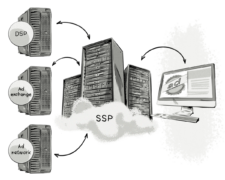Back when print publishers first started moving online, they soon discovered they needed a way to generate some revenue, so they looked at the main revenue model they’d been using in print—advertising—and aimed to replicate that in the online world.
Display ads seemed to be the most intuitive way to monetize their content. To do this, publishers could sell some of their advertising space via direct sales by finding advertisers willing to display their ads on the publisher’s website, but because of a certain fill risk involved in the process (some inventory could end up unsold), there was a need for a platform that would allow them to sell their remnant inventory.
That’s where the ad network came in.
What Is an Ad Network and How Does it Work? from Clearcode on YouTube.
What Is an Ad Network?
An ad network is a technology platform that serves as a broker between a group of publishers and a group of advertisers. Ad networks were one of the first pieces of advertising technology that appeared in the mid ‘90s when online advertising first began. They were responsible for the very same things they are today—helping advertisers buy available ad space (aka inventory) across multiple publishers.
While you would expect the term “ad network” to include all sorts of media (printed media, television, radio), it is used exclusively to refer to online advertising.
Ad networks traditionally collect unsold ad inventory from multiple publishers and offer this pool of impressions to advertisers at a much lower price than a publisher’s direct sales. This kind of inventory is often referred to as non-premium, or remnant.
Today, however, some networks take a more strategic approach and lean towards offering their advertisers more exclusive deals at premium prices. They cherry-pick and pre-buy inventory from a number of top-tier publishers, and then resell it at premium prices. While this arrangement may be more expensive for the advertisers, it ensures premium placement of their ads.
What Is the Difference Between an Ad Network and Ad Server?
Because ad networks and ad servers were introduced to the industry at roughly the same time, and due to the complex nature of the online-advertising ecosystem and sheer number of advertising-technology platforms, it can be difficult to tell them apart.
We explained what an ad server is and how it works in one of our previous posts, but here’s a quick summary:
An ad server is a piece of advertising technology used by ad networks, publishers, advertisers, and ad agencies to manage, run, and report on their advertising campaigns.
There are two types of ad servers: first-party ad servers (a publisher’s ad server) and third-party ad servers (an advertiser’s ad server).
First-party ad servers allow publishers to manage inventory (ad space) on their websites, display ads sold via direct deals with advertisers, sell remnant (unsold) inventory to ad networks and supply-side platforms (SSPs), and report on ad performance.
Third-party ad servers are designed to help advertisers store their ads, measure campaign performance across several publishers, and verify metrics against reports from publishers, such as impressions and clicks.
An ad network is also a piece of advertising technology, but instead of being used to manage ad campaigns and store creatives, it is used to transact media buys between advertisers and publishers.
An SSP (supply-side platform) is the technology alternative to an ad network, offering similar functionality, but with access to a different kind of inventory and delivery (purchase) method. More on the difference between the two to follow.
We Can Help You Build an Ad Network
Our AdTech development teams can work with you to design, build, and maintain a custom-built demand-side platform (DSP) for any programmatic advertising channel.
How Does an Ad Network Work?
Ad networks take all of the available inventory from a publisher and sell it to advertisers as packaged impressions.
Here’s how an ad network works:
- An ad network aggregates a large number of publishers to provide the required amount of inventory to the advertisers on an auction basis.
- The advertiser can set up the campaigns directly using an ad network’s campaign-management panel, or set up pixels from a third-party ad server for verification purposes and consolidated reporting when running the campaign across multiple ad networks and in direct deals with publishers.
- The advertiser sets up the campaign parameters (such as targeting, budget, frequency caps, etc.), and the publisher installs the ad-network ad tags on their site by inserting these tags directly into the page or by using a first-party ad server.
- When the ad is published, the advertiser can rotate multiple banners on the website using the ad network’s campaign-management panel without having to contact the publisher.
In the early days of online advertising when there were fewer sites and advertisers, most publishers would only use one ad network to sell remnant inventory. However, as the number of publisher sites increased, they soon found that they weren’t able to sell all of their inventory on one ad network and suffered from low fill rates.
In an attempt to increase fill rates, publishers started using multiple ad networks, some of them offering premium inventory and others offering remnant inventory.

This situation where ad networks are called one after another is known as waterfalling.
How Do Ad Networks Benefit Advertisers and Publishers?
Publishers
The most obvious benefit for publishers is the opportunity to sell inventory that wasn’t sold via direct deals, although it does not save the publisher from “wasting” impressions—i.e. not being able to achieve high fill and sell all their ad inventory.
Advertisers
While ad networks are mainly responsible for helping publishers sell remnant inventory, they also provide advertisers with many benefits:
Scale: An advertiser can buy more inventory from many publishers through an intermediary and centralize the reporting for the campaign.
Time Savings: An advertiser sets up the campaign once and does not need to sign insertion orders for each publisher separately.
Campaign Reach and Measurement: The reach of the campaign will be measured and frequency capping will be applied to the whole campaign.
The Different Types of Ad Networks
Below are some of the main types of ad networks:
- Premium Ad Networks: Offer the inventory from popular publishers.
- Vertical Ad Networks: Topic-specific networks—e.g. business ad network, technology ad network, automotive ad network, fashion ad network, etc.
- Specialized or Inventory-Specific Ad Networks (e.g. Mobile, Video, Native): Focuses on a certain type of inventory.
- Performance and Affiliate Ad Networks: Typically using the revenue share, CPC, or CPA pricing model.
With traditional ad networks, an advertiser buys a “package” of impressions on a CPM basis.
IAB categories:
- Geolocation
- Keywords (context)
- Time of day
- Browser type / OS
- … and many others
Here some examples of popular ad networks:
Evolution of Ad Networks?
There is an ongoing competition for market share between supply-side platforms and ad networks, who fight for publishers and advertising revenue. At the same time, both are increasingly trying to offer some functionalities of the other, significantly blurring the line between them.
Since marketers are seeking a one-in-all solution, we are currently witnessing a “two become one” scenario—ad networks are increasingly beginning to offer various functionalities of SSPs.
Conversely, trying to attract premium publishers, SSPs are implementing certain features of ad networks. They allow advertisers to buy directly, which makes them similar to ad networks in the way that they connect the supply side with the demand side. This usually involves evolution towards programmatic direct (more on programmatic direct below).
This further blurs the line between them.
For example, ad networks’ slowly transcend premium inventory as they add programmatic engines that optimize the procured RTB supply. On top of that, they’re also connecting their own remnant supply to selected DSPs in a bid to increase fill rates for their portfolio of publishers.
Programmatic Direct
Programmatic direct is a new, alternative solution to ad networks that makes the sale of display advertising less complex, and cheaper. It automates the process of direct ad-buying for campaigns. It is a non-RTB (non-real time and non-auction) method whereby guaranteed ad impressions are bought in advance from select premium sites.
Programmatic direct, simply put, is technology that enables the possibilities of an ad network with a dedicated self-service panel for publishers and advertisers.
The technique mimics the direct buys from publishers, where impressions can be considered on an individual basis (i.e. advertisers can choose to target only particular placements on a website).
On top of standard targeting available in pretty much any ad server/ad network, programmatic direct often relies on third-party data. Just like in the case of a private marketplace, it allows a more precise and nuanced way of buying inventory. The purchase process utilizes the benefits of programmatic.
On behalf of the publisher, sales reps can negotiate inventory purchase deals with advertisers. This method allows marketers to better control the price levels of their ads, have stronger control over inventory, and ensure premium placements.
Programmatic direct allows both parties to avoid intermediaries in the form of real-time bidding. Publishers can provide advertisers with access to their inventory through a self-service platform like AdSlot, where marketers place their purchase orders directly, and can even build their ads from scratch.
The above video comes from AdSlot and explains how their self-service platform works.
We Can Help You Build an Ad Network
Our AdTech development teams can work with you to design, build, and maintain a custom-built demand-side platform (DSP) for any programmatic advertising channel.








